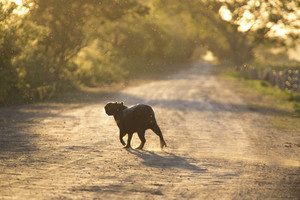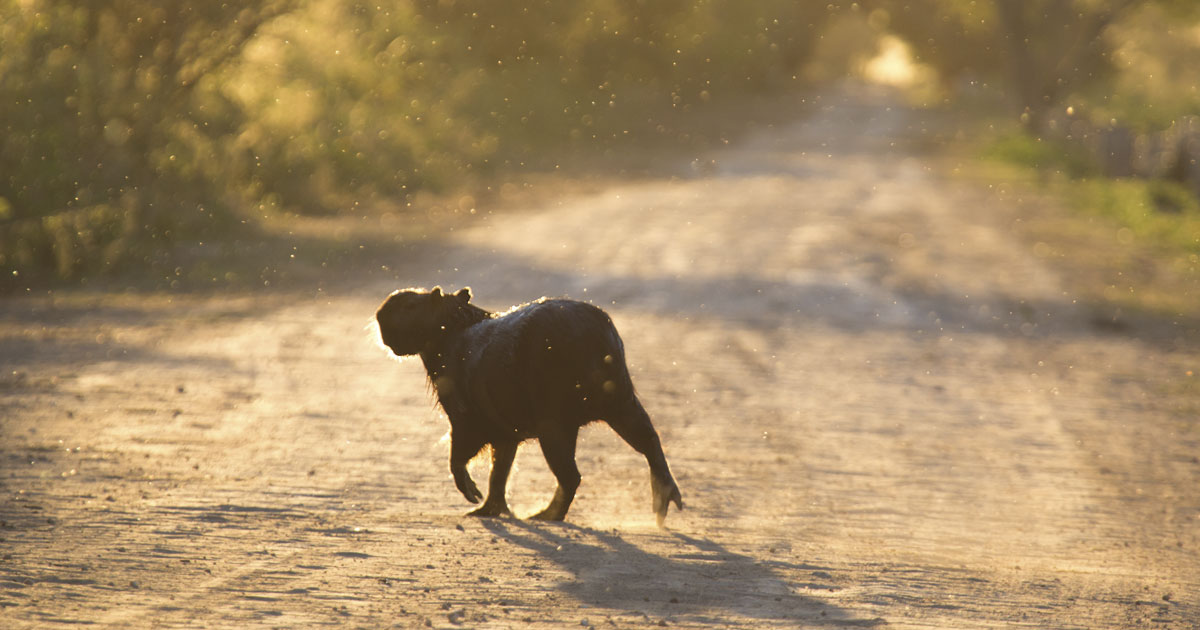
ALEX SABERI / GETTYIMAGES
Five million large animals, such as capybaras, jaguars, and monkeys are killed every year on Brazilian roadsALEX SABERI / GETTYIMAGESAround 1,200 collisions with wild and domestic animals were recorded last year on the 6,900 kilometers (km) of privatized São Paulo highways, according to data from the São Paulo State Transportation Agency (ARTESP). Taking into consideration the state’s entire highway system comprising 35,000 km of paved roads, 4% of accidents are caused by collisions with animals, some of them fatal to vehicle occupants. Data on the problem at the national level is not available, but through analysis of 14 scientific studies using death records from a variety of biomes, the Brazilian Center for Road Ecology Research (CBEE) at the Federal University of Lavras (UFLA) estimates that 5 million large animals such as capybaras, jaguars, monkeys, and maned wolves are killed annually on the roads and highways of Brazil.
To reduce animal mortality and make highways safer, toll-road concessionaires and public agencies in the transportation sector have for some time adopted solutions to reduce the problem, such as the installation of fences or barriers along highways and the construction of subterranean passages for wildlife. Another recent possibility is animal-detection technology. One of these solutions, devised by the environmental consulting firm ViaFauna in São Paulo and named Passa-Bicho (“Animal Pass”), is an animal detection system based on positioning a set of sensors on stretches of roadway with high animal traffic. By means of warning lights or electronic message panels, the system will alert drivers about the existence of animals on the road (see infographic).

VIAFAUNA/PUBLICITY
Biologist Fernanda Abra of ViaFauna holds a striped hog-nosed skunk, popularly known as gambá, killed on a road that cuts through the Chapada dos Veadeiros National Park in the state of Goiás.VIAFAUNA/PUBLICITYViaFauna specializes in studies and wildlife management for highways, railways, and airports, and already has a functional Passa-Bicho prototype, capable of detecting wild and domestic animals larger than three kilos. The company expects to begin field testing in the coming months to refine the technology. “Our goal is to have a commercially available model by 2019. Highway deaths are one of the main factors in the reduction of wild animal populations around the world. In Brazil’s case, we’re talking about endangered species, such as the maned wolf, puma, and anteater,” says biologist Fernanda Delborgo Abra, one of the partners in the startup, with biologists Mariane Rodrigues Biz Silva and Paula Ribeiro Prist. The ViaFauna system is powered by solar energy, and was developed in partnership with Trapa Câmera, a company specializing in the manufacture of electronic equipment for wildlife conservation, such as cameras for filming animals in the forest.
Although not yet ready, the Passa-Bicho idea has already sparked market interest. “We want to do a pilot study on one of our highways with high animal traffic,” says Luciano Louzane, superintendent director of the Centrovias and Intervias concessionaire firms, which manage about 600 km of highways in the state of São Paulo. “Animal collisions are a serious problem. In one section of one of our highways there have been 700 occurrences involving capybara recorded. In addition to the loss of biodiversity, collisions affect the operation of the highway system, generate material losses, and endanger the lives of drivers and other vehicle occupants.”
Systems like the one developed by ViaFauna are unprecedented in Brazil, but are already working in Canada, the United States, the Netherlands, Finland, and Switzerland. “This type of technology reduces animal collisions by 90% in places where it’s been adopted. In addition to being able to be installed at any location on the highway, the system is highly efficient compared to other measures to reduce road kills, such as wildlife crossings, fences, concrete walls, and animal crossing signs,” Fernanda Abra points out. According to her, Passa-Bicho can also help highway ecology experts. “One of the biggest bottlenecks in this field of research is knowing how many animals cross the highway successfully. Today, we only have data on the animals that die on the road.”
 Urubu safe
Urubu safe
According to oceanographer Alex Bager, CBEE coordinator and ecology professor at UFLA, animal detection technologies such as Passa-Bicho can make Brazilian highways safer, but to do so, one must carefully consider one question: the location where they will be installed. “Making the decision about the precise point where the system is going to be deployed is crucial to its success. It’s necessary to identify the so-called hotspots, which are the critical places where animals are hit,” he advises.
In order to assist with the necessary mapping, the CBEE has developed a free mobile phone app that can gather information on animal mortality on roadways. Named Sistema Urubu (the Vulture System), it collects road kill data provided by drivers, researchers, concessionaires, and government agencies. “Sistema Urubu is a large social network for biodiversity conservation. Almost 22,000 people have already downloaded the app and are participating in the initiative, recording the occurrence of accidents involving wild animals,” says Bager. To participate, the user only needs to photograph the animal that’s been hit and send the image, via the app, to the CBEE researchers.
Based on data from Sistema Urubu, UpgradeX, a startup that operates from the UFLA Technology-Based Business Incubator (INBATEC-UFLA), has created a road safety application, Urubu Safe (Vulture Safe), to model the risk of an animal collision across the entire Brazilian highway network. “The probability is based on actual accident records and accounts for parameters such as the season and annual traffic variations, among others,” said Bager, a partner at UpgradeX. “With the app, drivers will see accident-probability information for every kilometer of the highway and can become more alert at the critical locations.” UpgradeX plans to sell the app to roadway concessionaires, logistics companies, and highway users.
Monitoring the rails
Concessionaire creates app for preventing accidents with animals on railway tracks
Collisions with animals also affect the rail sector, although there are no statistics showing the scale of the problem on railway tracks. In May of this year, Rumo, a concessionaire that manages 12,000 km of Brazil’s rail network, including the lines accessing the ports of Santos (São Paulo State) and Paranaguá (Paraná State), adopted a new measure to prevent collisions between locomotives and animals.
Operating with the same logic as the Sistema Urubu, their Alerta Atropelei um Animal (Animal Hit On the Tracks Alert) tool allows real-time record keeping of animal collisions. It is hosted within the Chave na Mão (Key in Hand) app already in use by Rumo engineers for communicating events occurring on the railway line. Upon realizing that an animal has been hit, the engineer triggers the alert button and information regarding the time of the event and its location is passed on to the environmental licensing department, which will analyze the data and seek solutions for preventing more accidents, such as building fences along the railway, or tunnels under the tracks.
“Since the Alerta Atropelei um Animal system was implemented only a few months ago, there’s still not enough data collected for analysis. The first statistics should be available by the end of the year,” says Stefani Gabrieli Age, Rumo’s environmental licensing coordinator. Another measure taken by the company to deal with the problem was the construction of underground animal crossings. According to Gabrieli, cameras installed in the 70 tunnels in operation in Rumo’s Northern Network, which runs from Rondonópolis, Mato Grosso, to Aparecida do Taboado, Mato Grosso do Sul, captured images of 4,573 animals in transit between 2014 and 2016.
Project
Development of the “Passa Bicho” animal detection system for collision prevention on highways (No. 15/08607-7); Grant Mechanism The Technological Innovation in Small Businesses Program (PIPE); Principal Investigator Fernanda Delborgo Abra (ViaFauna); Investment R$143,904.61.
